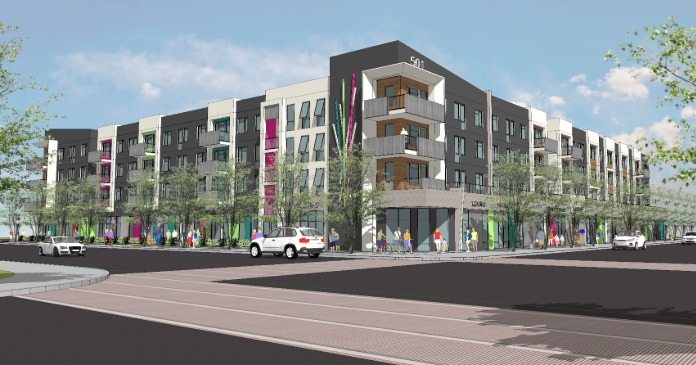The Employment Situation Report from the Bureau of Labor Statistics (BLS) stated employment grew in June, but many of the jobs added were in government, health care and social assistance. The employment levels for 3 of the 4 multifamily-related job categories we track were reported to be higher than the levels reported last month.
Government jobs dominate rise in employment
The BLS reported that total seasonally adjusted non-farm employment increased by 147,000 jobs (+0.09 percent) to 159,724,000 jobs in June, based on their survey of business establishments. This compares to the monthly average employment gain of 130,000 jobs over the last 6 months. In addition, last month’s employment level was revised higher by 5,000 jobs in this month’s report to 144,000 jobs. However, the June job gains were concentrated in the government or government-adjacent categories of health care and social assistance with a total of 131,000 jobs added in these categories. This is despite the Federal government shedding 7,000 jobs.
The history of the overall U.S. employment level is shown in the first chart, below. It also shows trend lines for both the pre-pandemic and post-pandemic periods, the latter since May 2023. While both periods show steady employment growth, the new trend not only starts at a lower employment level, but it has a lower slope, meaning that fewer jobs are being added each month than for the pre-pandemic trend.
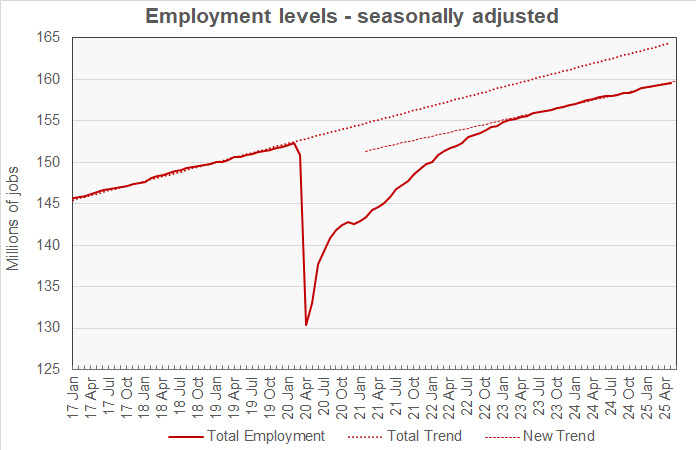
The BLS household survey reported that the US unemployment rate fell to 4.1 percent. When computed to 2 decimal places, the unemployment rate fell from 4.24 percent to 4.12 percent. The household survey found that the number of employed people was 163,366,000. This is 93,000 people more than the figure reported last month. The number of unemployed people was 7,015,000, down 222,000 from last month’s reported figure.
The household survey also found that the number of people in the civilian labor force was 170,380,000, down by 130,000. The labor force participation rate fell by 0.09 percentage points to 62.28 percent. It had been at 63.33 percent before the pandemic. Recovering that 1.05 percent decline in the labor force participation rate would bring 2.88 million more people into the workforce.
The next chart shows the recent reports on total employment based on the survey of business establishments. It shows that revisions to the employment data in the report for May were large and to the downside while revisions to the employment data in the report for June were small and to the upside.
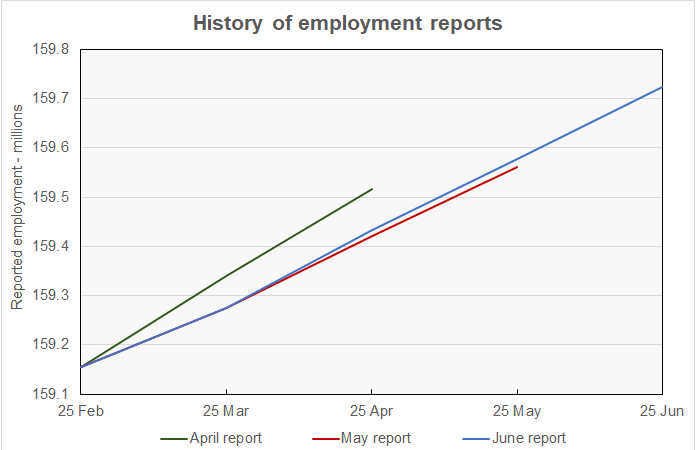
Tracking multifamily employment
The BLS reported more detailed employment information on four job categories of interest to the multifamily industry. These are employment as residential construction workers, as specialty trades within residential construction, as residential property managers and as lessors of residential buildings. As usual, some of the data was reported with a one month delay, so the latest figures for the latter two categories are for the month of May.
Residential construction employment higher
The next chart shows the history of the levels of employment since 2017 in the two construction jobs categories we track.
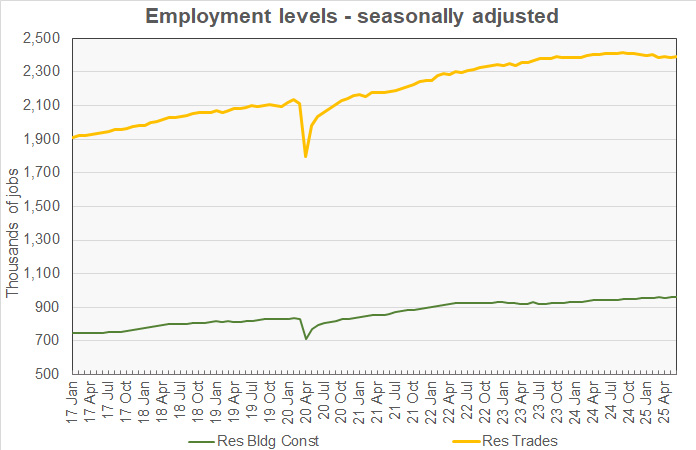
In June, residential building construction jobs, usually with general contractors, were reported to be down by 500 jobs. In addition, the prior month’s employment level was revised lower by 3,800 jobs so reported employment in this category is 4,300 jobs lower than the preliminary value reported last month. Employment in this category is now 958,500 jobs, up 1.7 percent year-over-year.
Employment in residential building trades, i.e. plumbers, electricians, etc., in June was reported to be up by 10,000 jobs from last month’s level. In addition, the May jobs figure was revised higher by 4,200 jobs so employment in this category is 14,200 jobs higher than the level reported last month. Employment in residential building trades is now 2,394,400 jobs, down 0.5 percent year-over-year.
Total June employment in these two categories of residential construction jobs combined is up 0.28 percent from the revised level of the month before. It is up 0.08 percent year-over-year.
Property management jobs also higher
The next chart shows the history of the levels of employment since 2017 in the two property management jobs categories we track.
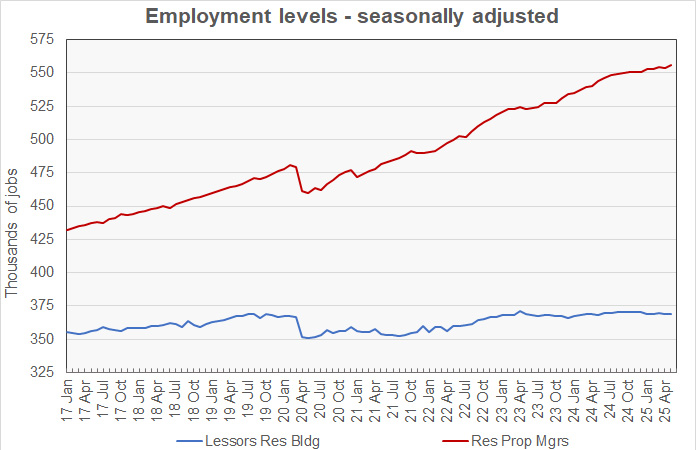
Employment for residential property managers in May was reported to be up by 2,000 jobs from its revised (+500 jobs) level for April to 555,600 jobs. Employment in this category is up 2.2 percent year-over-year.
Employment for lessors of residential buildings in May was reported to be unchanged from its revised (+100 jobs) level for April at 369,300 jobs. Employment in this category is up 0.2 percent year-over-year.
Total employment in these two categories of apartment operations jobs combined was reported to be up 0.22 percent from the revised level for last month and up 1.40 percent year-over-year.
Multifamily employment trails trends
The final chart, below, presents the employment data in a different format. It normalizes the employment levels in each of the four jobs categories to a reading of 100 for January 2015. It also provides trend lines for the growth in each of the categories of employment based on the period from January 2015 through February 2020.
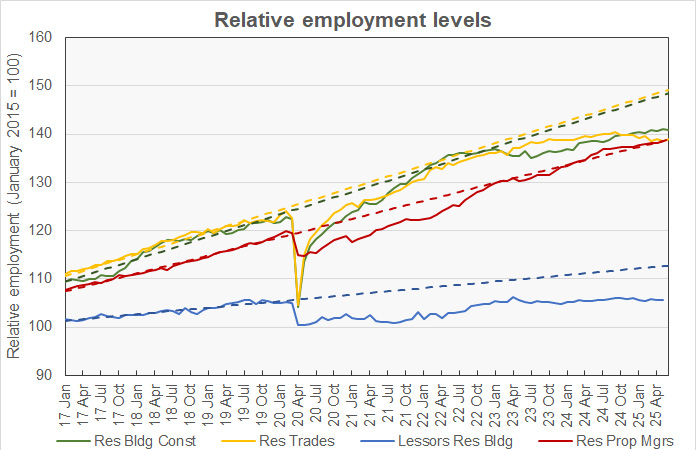
Residential building construction employment is now 5.1 percent below trend. Residential trades employment is now 6.8 percent below trend. Residential property managers employment is even with its trend and lessors of residential buildings employment is now 6.2 percent below trend.
The numbers given in the Employment Situation report are seasonally adjusted and are subject to revision. It is common for small adjustments to be made in subsequent reports, particularly to the data for the most recent month. The current Employment Situation report can be found here.





